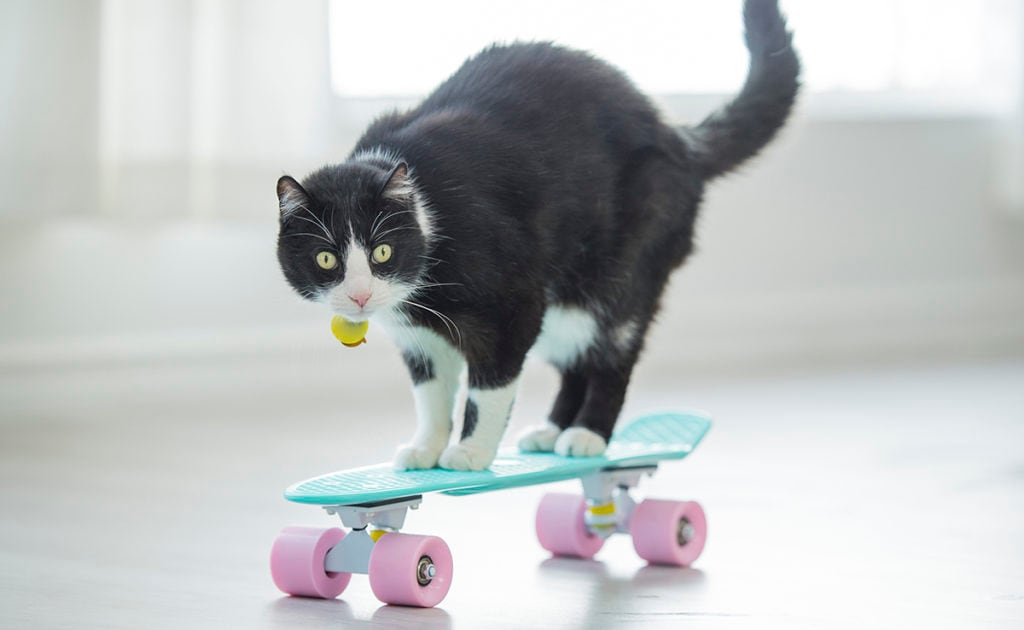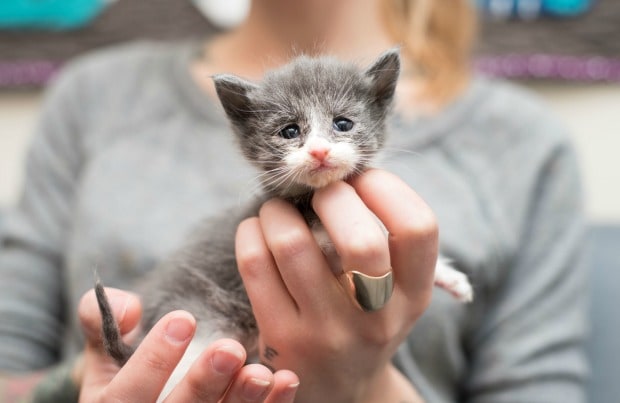When your cat has taken refuge under the bed or next to an air conditioning vent during the peak of summer, it’s easy to assume that she’s content to lounge away the warm-weather months.
However, despite the heat, cats still need stimulation and exercise to prevent boredom.
“Summer is an easy time to overlook our cat’s needs because it’s our playtime,” says Pam Johnson-Bennett, an author and certified cat behaviorist. “No matter how much you pack into your summer schedule, you’re your cat’s whole world, so don’t skimp on that time.”
Here are six activities to keep your cat engaged and happy all summer long:
1. Play Go Fish
Water sports may not be the first thing you think of to occupy your cat’s time, but Ingrid Johnson, a certified cat behavior consultant and veterinary technician, says cats find some gentle water activity very appealing.
The movement of a ping pong ball floating around in the bathroom sink or container of water may tempt your kitty to scoop her paw in the water and “go fish.”
“It can be a fun activity especially for breeds like Bengals who like water,” Johnson-Bennett says. “[But] be careful that you don’t create a secondary behavioral problem. If you don’t like the idea of inviting your cat up on the bathroom counter, you can use a large heavy bowl in a place she’s allowed to go.”
If your cat is less than amused with trying to capture floating balls, try upping the entertainment factor by swapping in some battery-powered floating cat toys.
“I’ve seen owners put treats on an auto-propelled floating toy. The cat has to scoop the toy over to get the treat,” Johnson says.
2. Build a Rooting Box
People make rooting boxes for pigs so they can dig for treats and grubs, and cats are similar foragers by nature.
It’s easy to create a feline rooting box from a cardboard box, old cat litter box or storage tote with anything seasonal that is non toxic. Fill it up with dried leaves, sticks, grass clippings or river rocks and let your cat dig, explore, forage or just sleep on a unique texture and enjoy new scents.
“Throw in some of your cat’s favorite treats and toys and they can dig around and discover. It’s like playing in the grass and hunting crickets,” Johnson says.
If your kitty takes to indoor treasure hunting, consider making it a year-round activity.
“Just be careful about what you choose,” she says. “You want to make sure you’re not hitting your yard hard with pesticides and then turning around and putting clippings from your yard in the box.”
3. Make Some Frozen Treats
It’s easy to treat your kitty to a cool treat, just add low-or-no sodium broth and some meat to ice cube trays and freeze. Once they’re frozen, place the treats on a cookie sheet or your cat’s water bowl and let her forage for a cool snack.
“Cats are small, so the cubes should be small,” Johnson-Bennett says. “I don’t fill each cube all the way to the top with broth. I use their regular food or a piece of plain boiled chicken or dehydrated chicken treats.”
It may take a few tries to get the right combination down that suits your kitty’s palate and temperament. And for cats with high blood pressure or kidney issues, it’s important to use no-sodium broth.
4. Plant a Cat-Friendly Garden
Planting a kitty garden with greens such as cat grass will help aid in digestion and give your cat a special place to frolic, roam and forage.
“I like to use a long, thin square container about four inches deep covered with gutter guards,” Johnson says. “The guards bend and clamp on for protection until the blades of grass come up, that way [your cat] can’t dig in to it or use it as a litter box.”
Once your crop has fully sprouted, Johnson-Bennett recommends monitoring your kitty’s access to catnip.
“Growing grass indoors is safe and clean for your cat [but] you don’t want to expose your cat to it everyday,” she says. “Snip a few pieces of grass or catnip and put on the floor for your cat to find.”
5. Take a Walk Outside
Taking your cat on walk in a stroller can be a fun way to expose her to the sights, sounds and smells of the great outdoors. But before you enlist her to be your morning walking buddy, you’ll need to do a bit of preparation.
“Some cats are social butterflies [but] some may be too timid or scared. Know your cat’s limitations and personality. You want it to be positive and enriching, not stressful,” Johnson-Bennett says.
Choose a stroller that has the proper weight and space capacity for your cat and make sure your cat is wearing a collar with proper identification tags and that they’ve been micro chipped.
“Even if the stroller is safe and escape free, cats can be like Houdini,” Johnson-Bennett says. “Inspect it before and after every trip to make sure there are no tears you weren’t aware of the last time.”
Many strollers are screened on all sides so your cat has a protected view of the action, but if she gets spooked, Johnson says it’s a good idea to bring a towel along to cover her up.
Once you’ve chosen the right stroller, Johnson recommends getting your cat comfortable with it slowly, giving her treats in the stroller in your home, then moving on to taking small trips around the yard then around the block.
6. Try Skateboarding
It’s possible to teach your cat to ride a skateboard (yes, really) with clicker training, and Johnson says it is one of her favorite enrichment activities.
“Cats are great at agility. They’re more acrobatic than dogs. They just need to be trained,” Johnson says.
She recommends teaching a cat to skateboard only once she has an understanding of clicker or reward-based training.
“It’s best to work with a cat who has experience with target training, which teaches the cat to touch something or to go somewhere,” she says.
If you’re game to try and get your kitty on four wheels, here’s what Johnson recommends:
- With the skateboard on a carpet or stationary surface, encourage your cat to step on the board on her own. Mark each time she steps on the board with a click or treat.
- Increase her comfort with the board by doing some training on it. Ask for a command she already knows, like “sit,” and repeat the sequence a few times, marking the action with a click or treat each time.
- Move the board so two of the wheels are on a hard floor or surface. This will help her experience some slight movement.
- When she’s accustomed to the movement, slowly roll all of the wheels onto a hard floor or surface, keeping the board secure by resting your hand or foot under the board.
- Finally, give the board a gentle push so she can get used to the sensation of gliding on a rolling surface.

Katherine Tolford writes features that connect readers to insightful stories and topics about animals, people and culture.
Share:









